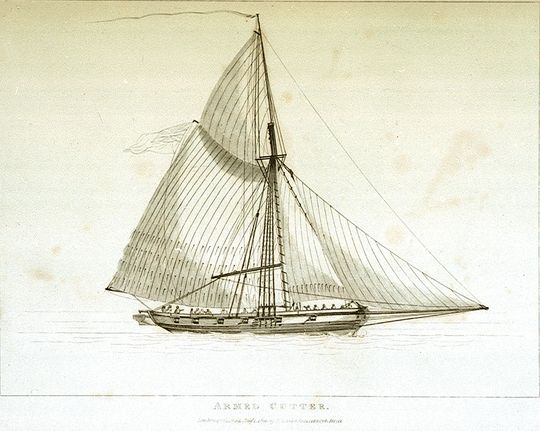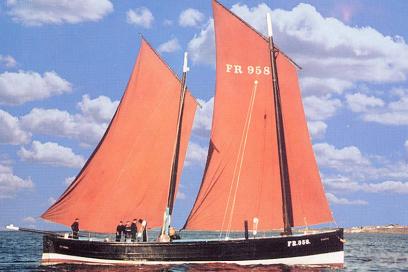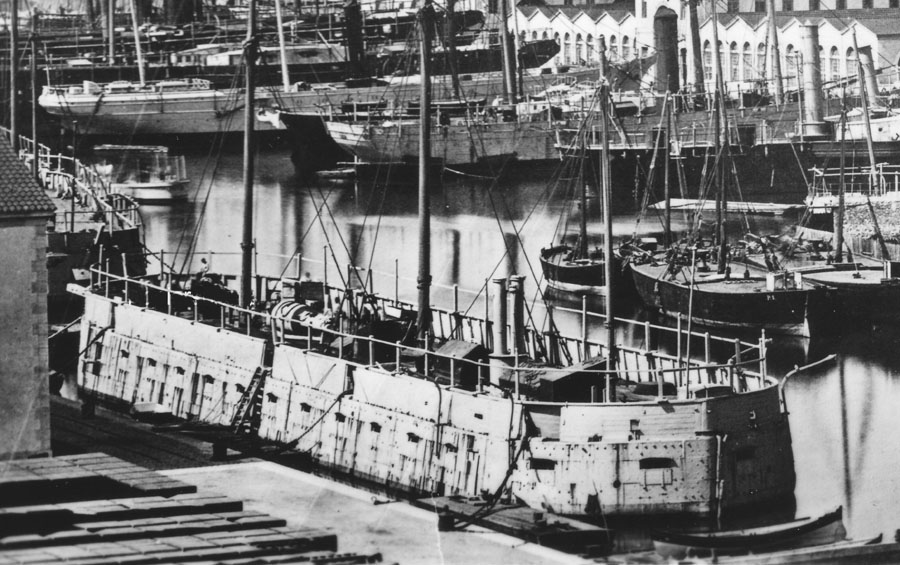|
Hired Armed Lugger Daphne
The hired armed lugger ''Daphne'' served the Royal Navy from 2 November 1794 to 19 December 1796. She was armed with twenty-two 4-pounder guns and was of 160 tons burthen ( bm) Naval career ''Daphne'' apparently served at Jersey together with ''Aristocrat'' and ''Royalist'' in a small squadron under the command of Captain Philippe d'Auvergne, in the 16-gun ''Firm''-class floating battery . ''Daphne''s commander was a Lieutenant Robert Pearson. She was employed maintaining communications with French Royalists in Normandy. Possible origins ''Daphne'', of 160 tons (bm), was launched in 1787 at Poole, appeared in ''Lloyd's Register'' in 1793, but was not listed either in 1792 or in 1794. Her master was J. Banfield, her owner St Barbe & Co., and her trade London–Smyrna. Earlier, a lugger ''Daphne'' had received two letters of marque. The first, dated 30 July 1793, gave the name of her master as Patrick Henvey. It described her as being of 160 tons (bm), with a crew of 60 me ... [...More Info...] [...Related Items...] OR: [Wikipedia] [Google] [Baidu] |
Hired Armed Vessels
During the eighteenth and nineteenth centuries the Royal Navy made use of a considerable number of hired armed vessels. These were generally smaller vessels, often cutters and luggers, that the Navy used for duties ranging from carrying and passengers to convoy escort, particularly in British coastal waters, and reconnaissance.Winfield (2008), p.387. Doctrine The Navy Board usually hired the vessel complete with master and crew rather than bareboat. Contracts were for a specified time or on an open-ended monthly hire basis. During periods of peace, such as the period between the Treaty of Amiens and the commencement of the Napoleonic Wars, the Admiralty returned the vessels to their owners, only to rehire many on the outbreak of war. The Admiralty provided a regular naval officer, usually a lieutenant for the small vessels, to be the commander. The civilian master then served as the sailing master. For purposes of prize money or salvage, hired armed vessels received the same ... [...More Info...] [...Related Items...] OR: [Wikipedia] [Google] [Baidu] |
Lugger
A lugger is a sailing vessel defined by its rig, using the lug sail on all of its one or several masts. They were widely used as working craft, particularly off the coasts of France, England, Ireland and Scotland. Luggers varied extensively in size and design. Many were undecked, open boats, some of which operated from beach landings (such as Hastings or Deal). Others were fully decked craft (typified by the Zulu and many other sailing drifters). Some larger examples might carry lug topsails. Luggers were used extensively for smuggling from the middle of the 18th century onwards; their fast hulls and powerful rigs regularly allowed them to outpace any Revenue vessel in service. The French three-masted luggers also served as privateers and in general trade. As smuggling declined about 1840, the mainmast of British three-masted luggers tended to be discarded, with larger sails being set on the fore and mizzen. This gave more clear space in which to work fishing nets. Local ... [...More Info...] [...Related Items...] OR: [Wikipedia] [Google] [Baidu] |
Royal Navy
The Royal Navy (RN) is the United Kingdom's naval warfare force. Although warships were used by English and Scottish kings from the early medieval period, the first major maritime engagements were fought in the Hundred Years' War against France. The modern Royal Navy traces its origins to the early 16th century; the oldest of the UK's armed services, it is consequently known as the Senior Service. From the middle decades of the 17th century, and through the 18th century, the Royal Navy vied with the Dutch Navy and later with the French Navy for maritime supremacy. From the mid 18th century, it was the world's most powerful navy until the Second World War. The Royal Navy played a key part in establishing and defending the British Empire, and four Imperial fortress colonies and a string of imperial bases and coaling stations secured the Royal Navy's ability to assert naval superiority globally. Owing to this historical prominence, it is common, even among non-Britons, to ref ... [...More Info...] [...Related Items...] OR: [Wikipedia] [Google] [Baidu] |
Builder's Old Measurement
Builder's Old Measurement (BOM, bm, OM, and o.m.) is the method used in England from approximately 1650 to 1849 for calculating the cargo capacity of a ship. It is a volumetric measurement of cubic capacity. It estimated the tonnage of a ship based on length and maximum beam (nautical), beam. It is expressed in "tons burden" ( en-em , burthen , enm , byrthen ), and abbreviated "tons bm". The formula is: : \text = \frac where: * ''Length'' is the length, in foot (length), feet, from the stem (ship), stem to the sternpost; * ''Beam (nautical), Beam'' is the maximum beam, in feet. The Builder's Old Measurement formula remained in effect until the advent of steam propulsion. Steamships required a different method of estimating tonnage, because the ratio of length to beam was larger and a significant volume of internal space was used for boilers and machinery. In 1849, the Moorsom System was created in the United Kingdom. The Moorsom system calculates the cargo-carrying capaci ... [...More Info...] [...Related Items...] OR: [Wikipedia] [Google] [Baidu] |
Jersey
Jersey ( , ; nrf, Jèrri, label=Jèrriais ), officially the Bailiwick of Jersey (french: Bailliage de Jersey, links=no; Jèrriais: ), is an island country and self-governing Crown Dependencies, Crown Dependency near the coast of north-west France. It is the largest of the Channel Islands and is from the Cotentin Peninsula in Normandy. The Bailiwick consists of the main island of Jersey and some surrounding uninhabited islands and rocks including Les Dirouilles, Écréhous, Les Écréhous, Minquiers, Les Minquiers, and Pierres de Lecq, Les Pierres de Lecq. Jersey was part of the Duchy of Normandy, whose dukes became kings of England from 1066. After Normandy was lost by the kings of England in the 13th century, and the ducal title surrendered to France, Jersey remained loyal to the The Crown, English Crown, though it never became part of the Kingdom of England. Jersey is a self-governing Parliamentary system, parliamentary democracy under a constitutional monarchy, with its ... [...More Info...] [...Related Items...] OR: [Wikipedia] [Google] [Baidu] |
Hired Armed Lugger Aristocrat
His Majesty's hired armed vessel ''Aristocrat'' served the Royal Navy, twice, as a lugger from 1794 to 1798, and as a brig from 1799 to 1801. She served with the Jersey-based Channel Islands flotilla under Commodore Philippe d'Auvergne, Prince of Bouillon. As a lugger she participated in two notable engagements, the second of which won for her crew the Naval General Service Medal, awarded some 50 years later. As a brig, she captured two privateers. HM hired armed lugger ''Aristocrat'' On her first contract, ''Aristocrat'' served from 2 November 1794 to 9 December 1798. The owner and original master of the vessel were Mr Henry Wilkins. She was armed with four 6-pounder and eight 4-pounder guns.''Naval Chronicle'', Vol. 15, pp.310-4. She was of 172 tons ( bm), and Admiralty records later give her armament as twenty-two 4-pounder guns. In 1793, at the beginning of the French Revolutionary Wars, the Governor of Jersey Alexander Lindsay had opened communications between England and ... [...More Info...] [...Related Items...] OR: [Wikipedia] [Google] [Baidu] |
Hired Armed Lugger Royalist
The hired armed lugger ''Royalist'' served the Royal Navy from 1798 to 1800 and she was armed with eight guns. She may have been built in 1798. ''Royalist'' apparently served at Jersey with ''Aristocrat'' and ''Daphne'' in a small squadron under the command of Commodore Philippe d'Auvergne } Philippe d'Auvergne (13 November 1754 – 18 September 1816) was a British naval officer and the adopted son of Godefroy de La Tour d'Auvergne the sovereign Duke of Bouillon. He chose a career in the Royal Navy that spanned a period of history w ... in . ''Royalist''s commander, as of 1 January 1799, was Lieutenant Jackson Dowsing. He had earlier served on the same station and in the same role on . Citations References * {{DEFAULTSORT:Royalist, Hired armed lugger Hired armed vessels of the Royal Navy 1790s ships ... [...More Info...] [...Related Items...] OR: [Wikipedia] [Google] [Baidu] |
Philippe D'Auvergne
} Philippe d'Auvergne (13 November 1754 – 18 September 1816) was a British naval officer and the adopted son of Godefroy de La Tour d'Auvergne the sovereign Duke of Bouillon. He chose a career in the Royal Navy that spanned a period of history where Great Britain was at the centre of wars and empire building and took him from Boston and the War of Independence to espionage with French Royalists; prisoner of war to shipwrecked; all this whilst hoping to become a Walloons, Walloon ruler or, at least, heir to a princely fortune. Early life Philippe D'Auvergne was born in Jersey, where his family had lived for four centuries. His mother Elizabeth, the daughter of Philip Le Geyt, died giving birth to him. His father, Charles, was an ex-British Army officer, advisor to British Cabinet Committees and aide-de-camp to various Governors; they included John Huske, Governor from 1749 to 1761, who left Charles £2,000 when he died in January 1761. His younger half brother, Corbet James D'Au ... [...More Info...] [...Related Items...] OR: [Wikipedia] [Google] [Baidu] |
Firm Class
A company, abbreviated as co., is a legal entity representing an association of people, whether natural, legal or a mixture of both, with a specific objective. Company members share a common purpose and unite to achieve specific, declared goals. Companies take various forms, such as: * voluntary associations, which may include nonprofit organizations * business entities, whose aim is generating profit * financial entities and banks * programs or educational institutions A company can be created as a legal person so that the company itself has limited liability as members perform or fail to discharge their duty according to the publicly declared incorporation, or published policy. When a company closes, it may need to be liquidated to avoid further legal obligations. Companies may associate and collectively register themselves as new companies; the resulting entities are often known as corporate groups. Meanings and definitions A company can be defined as an "artificial pe ... [...More Info...] [...Related Items...] OR: [Wikipedia] [Google] [Baidu] |
Floating Battery
A floating battery is a kind of armed watercraft, often improvised or experimental, which carries heavy armament but has few other qualities as a warship. History Use of timber rafts loaded with cannon by Danish defenders of Copenhagen against bomb ketches of a combined British-Dutch-Swedish fleet is attested by Nathaniel Uring in 1700. An early appearance was in 1782 at the Great Siege of Gibraltar, and its invention and usage is attributed to Spanish Lieutenant General Antonio Barceló. A purpose-built floating battery was ''Flådebatteri No. 1'', designed by Chief Engineer Henrik Gerner in 1787; it was long, wide and armed with 24 guns, and was used during the 1801 Battle of Copenhagen under the command of Peter Willemoes. The British made limited use of floating batteries during the French Revolutionary and Napoleonic Wars, with the two-vessel and -class floating batteries, and some individual vessels such as . The most notable floating batteries were built o ... [...More Info...] [...Related Items...] OR: [Wikipedia] [Google] [Baidu] |
National Maritime Museum
The National Maritime Museum (NMM) is a maritime museum in Greenwich, London. It is part of Royal Museums Greenwich, a network of museums in the Maritime Greenwich World Heritage Site. Like other publicly funded national museums in the United Kingdom, it has no general admission charge; there are admission charges for most side-gallery temporary exhibitions, usually supplemented by many loaned works from other museums. Creation and official opening The museum was created by the National Maritime Museum Act 1934 under a Board of Trustees, appointed by HM Treasury. It is based on the generous donations of Sir James Caird (1864–1954). King George VI formally opened the museum on 27 April 1937 when his daughter Princess Elizabeth accompanied him for the journey along the Thames from London. The first director was Sir Geoffrey Callender. Collection Since the earliest times Greenwich has had associations with the sea and navigation. It was a landing place for the Romans, Henry ... [...More Info...] [...Related Items...] OR: [Wikipedia] [Google] [Baidu] |
Chouannerie
The Chouannerie (from the Chouan brothers, two of its leaders) was a royalist uprising or counter-revolution in twelve of the western ''départements'' of France, particularly in the provinces of Brittany and Maine, against the First Republic during the French Revolution. It played out in three phases and lasted from spring 1794 to 1800.Albert Soboul (dir.), ''Dictionnaire historique de la Révolution française'', Quadrige/PUF, 1989, p. 217, "Chouans/Chouannerie" entry by Roger Dupu.] The uprising was provoked principally by the Civil Constitution of the Clergy (1790) and the mass conscription, or '' levée en masse'' (1793), which was decided by the National Convention. A first attempt at staging an uprising was carried out by the ''Association bretonne'' to defend the French monarchy and reinstate the specific laws and customs of Brittany, which had been repealed in 1789. The first confrontations broke out in 1792 and developed in stages into a peasant revolt, guerrilla ... [...More Info...] [...Related Items...] OR: [Wikipedia] [Google] [Baidu] |


.jpg)



